The impact of organizational culture and leadership climate on organizational attractiveness and innovative behavior: a study of Norwegian hospital employees
Peer reviewed, Journal article
Published version
Permanent lenke
https://hdl.handle.net/11250/3028389Utgivelsesdato
2022Metadata
Vis full innførselSamlinger
Sammendrag
Background: In the domain of health services, little research has focused on how organizational culture, specifcally internal market-oriented cultures (IMOCs), are associated with organizational climate resources, support for autonomy (SA), and whether and how IMOCs and SA are either individually or in combination related to employee perceptions of the attractiveness of the organization and their level of innovative behavior. These knowledge gaps in previous research motivated this study. Methods: A conceptual model was tested on a sample (N=1008) of hospital employees. Partial least-squares struc‑ tural equation modeling (PLS–SEM) was employed to test the conceptual models, using the SmartPLS 3 software. To test the mediator efect, a bootstrapping test was used to determine whether the direct and indirect efects were statistically signifcant, and when combining two tests, to determine the type of mediator efect. Results: The results can be summarized as four key fndings: i) organizational culture (referring to an IMOC) was posi‑ tively and directly related to SA (β = 0.87) and organizational attractiveness (β = 0.45); ii) SA was positively and directly related to both organizational attractiveness (β = 0.22) and employee individual innovative behavior (β = 0.37); iii) The relationships between an IMOC, SA, and employee innovative behavior were all mediated through organizational attractiveness; and iv) SA mediated the relationship between the IMOC and organizational attractiveness as well as that between the IMOC and employee innovative behavior. Conclusions: Organizational culture, IMOC, organizational climate resources, and SA were highly correlated and necessary drivers of employee perceptions of organizational attractiveness and their innovative behavior. Manag‑ ers of hospitals should consider IMOC and SA as two organizational resources that are potentially manageable and controllable. Consequently, managers should actively invest in these resources. Such investments will lead to resource capitalization that will improve both employee perceptions of organizational attractiveness as well as their innovative behavior.
Tidsskrift
BMC Health Services ResearchBeslektede innførsler
Viser innførsler beslektet ved tittel, forfatter og emneord.
-
Promoting organizational vision integration among hospital employees
Slåtten, Terje; Lien, Gudbrand; Mutonyi, Barbara Rebecca (Peer reviewed; Journal article, 2022)Background: The concept of organizational vision has been little explored in the health-care services research literature. To address this knowledge gap in the literature, the present study examines the factors that may ... -
Does organizational vision really matter? An empirical examination of factors related to organizational vision integration among hospital employees
Slåtten, Terje; Mutonyi, Barbara Rebecca; Lien, Gudbrand (Peer reviewed; Journal article, 2021)Background: There seems to be a consensus that a vision for an organization is a valuable thing for organizations to have. However, research on organizational vision has predominantly been studied from a leadership ... -
Profesjonalisering av brann- og redningsetaten En studie av ulike implikasjoner for samfunnet, etaten og dens personell når nye krav til ny kompetanse og økt profesjonalisering implementeres
Tvedten, Roger (Master thesis, 2020)Ettersom samfunnsutviklingen har skutt fart og byråkratiseringen har funnet sted, har det også forekommet en progressiv utvikling innen brann- og redningsetaten. Organisering, utrustning og bemanning er sentrale faktorer ...

